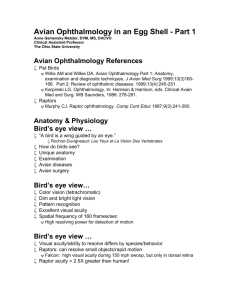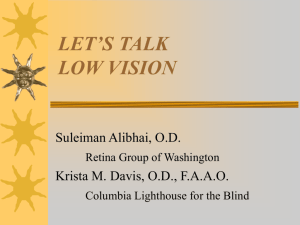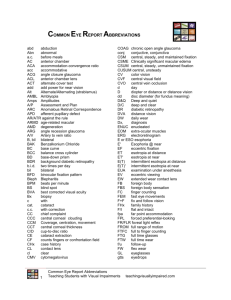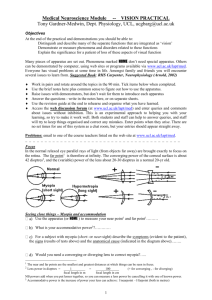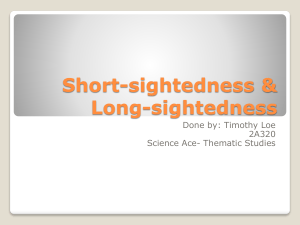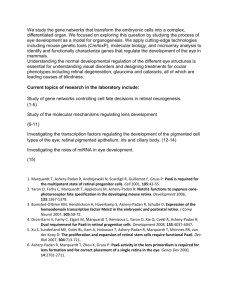Normal Ageing Vision - McGill Vision Research
advertisement
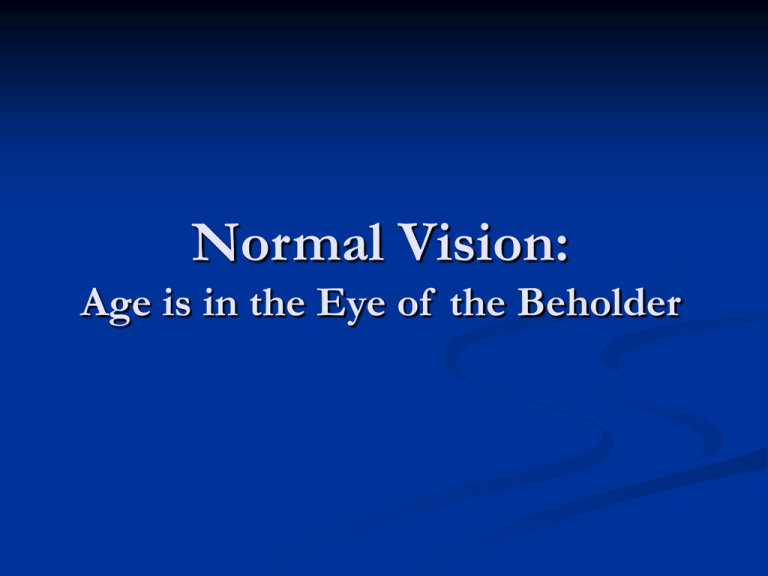
Normal Vision: Age is in the Eye of the Beholder NORTH AMERICANS ARE GETTING OLDER WE KNOW THIS ALREADY Most older people have “excellent” vision Some eye problems associated with age are annoying but do not cause visual loss NORMAL AGING VISION What exactly is “normal” in people over the age of 65? Definition: Having no immediately apparent structural or pathological defect that could account for reduced function (???) Conditions that occur in most older people (loss of accommodation, miosis) are considered normal NEAR POINT CHANGES www-staff.lboro.ac.uk Pupillary Miosis & Light Diameter of pupil in the dark minus diameter of pupil in bright light becomes less & less with age Consequence: reduction in retinal illuminance VISUAL DIFFICULTIES < 50% of people under the age of 40 wear refractive correction Approximately 90% of people in their 40s or beyond need lens correction VISUAL FUNCTION & AGE Up to age 70, loss in static corrected acuity can be explained by miosis & lens changes As age increases, the # of people who achieve normal corrected acuity decreases VERY IMPORTANT: These people show no signs of ocular disease CORNEA Corneal sensitivity decreases with age Touch threshold almost doubles between the ages of 10 and 80, especially after 40 Consider entropion & ectropion Advantages and disadvantages regarding contact lenses Corneal curvature changes with age Astigmatism increases throughout life ANTERIOR CHAMBER Depth of anterior chamber decreases At age 15-20, average depth = 3.6 mm At age 70, average depth = 3.0 mm This decrease in chamber depth could cause interference with aqueous flow LENS Lens grows throughout life Axial thickness increases by about 28% between the ages of 20 & 70 LENS Yellow pigment of the lens absorbs short wavelengths more than long ones Older people have decreased sensitivity in violet/blue end of the spectrum White objects may appear yellow & distinction between blues & greens is decreased LENS Older people need significantly more light to achieve the same level of retinal illuminance Visual performance of an older individual will be especially impaired at twilight Driving should be given much more thought (testing conditions vs. reality) RETINA & BEYOND In the absence of pathology, changes in the retina & further upstream are not directly observable Inferences must be made on the basis of visual function There’s the rub! Which function(s)? LIGHT, DARK & GLARE Older people Cannot reach the levels of dark adaptation that younger people can LIGHT, DARK & GLARE Older people - more sensitive to glare & take longer to recover VISUAL FUNCTION & AGE Inability to achieve at least 20/25 acuity cannot be explained for about 10% of people between the ages of 75 & 85 Visual acuity has long been understood (at least by the rehabilitation community) to be an inadequate measure of visual function HIGH - LOW CONTRAST ACUITY CONTRAST SENSITIVITY High-frequency cut-off can be mimicked by artificial pupils & neutral density filters This means that the lens and pupil changes are responsible for upper frequency loss. VERNIER ACUITY Observer is asked to align objects, not recognize them (hyperacuity task) Segments of a line, points of light, etc. are aligned vertically or horizontally This ability remains intact throughout life VERNIER ACUITY STILES-CRAWFORD EFFECT Tests the directional sensitivity of the retina Relies on proper alignment of the retinal receptors Light entering different points of the pupil is differently absorbed by receptors STILES-CRAWFORD EFFECT STILES-CRAWFORD EFFECT COLOUR PERCEPTION There has always been a debate concerning colour vision changes in older people Question: To what degree are changes in colour perception due to optical media (especially the lens) & to what extent are they due to retinal changes? Are the short-wavelength (blue) cones playing a big role? OPTICAL CORRECTION SYMMETRY PERCEPTION Detection of symmetry is an important visual ability Consider how many objects in our environment are approximately symmetrical (faces, butterflies etc) SYMMETRY PERCEPTION Our data show a decline in symmetry perception in people over 65 … but it’s an organized change USEFUL FIELD OF VIEW USEFUL FIELD OF VIEW USEFUL FIELD OF VIEW CONCLUSIONS It is extremely important to understand normal age-related changes in the visual system This avoids the error of attributing change to a pathology inappropriately It’s not all downhill … spread it around!!! Every man desires to live long, but no man would be old. Jonathan Swift 'Thoughts on Various Subjects'

